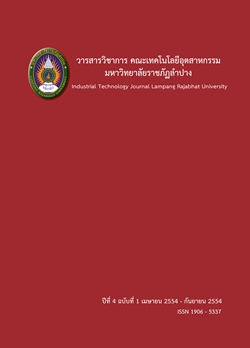การใช้กากดินขาวลำปางเป็นส่วนผสมในการผลิตผลิตภัณฑ์เครื่องปั้นดินเผา ชุมชนบ้านม่อนเขาแก้ว จังหวัดลำปาง
Keywords:
กากดินขาว, ดินขาว, ดินขาวลำปาง, เครื่องปั้นดินเผา, ม่อนเขาแก้ว, White clay residual, White clay, Lampang clay, Pottery, MonkaokaewAbstract
การศึกษาวิจัยครั้งนี้ มีวัตถุประสงค์เพื่อศึกษาสมบัติของเนื้อดินสำหรับผลิตภัณฑ์เครื่องปั้นดินเผาบ้านม่อนเขาแก้วที่ใช้กากดินขาวลำปางเป็นส่วนผสมแทนทราย วิธีดำเนินงานทดลองแบ่งเป็น 4 ขั้นตอน ขั้นตอนที่ 1 ศึกษาสมบัติทางกายภาพของดินม่อนเขาแก้วและกากดิน ขาวลำปาง ขั้นตอนที่ 2 ดำเนินการวิจัย เตรียมอัตราส่วนผสมดินม่อนเขาแก้ว 2 ส่วน ต่อ กากดินขาว 1 ส่วน ผสมน้ำร้อยละ 26 โดยน้ำหนัก ขึ้นรูปตัวอย่างขนาดเส้นผ่าศูนย์กลาง 1.2 เซนติเมตร ยาว 12 เซนติเมตร เผาตัวอย่างที่อุณหภูมิ 900 1000 และ 1100 องศาเซลเซียส ขั้นตอนที่ 3 ทดสอบ ผลการวิจัย ได้แก่ ความเหนียว การหดตัว การดูดซึมน้ำ และค่าความแข็งแกร่ง ขั้นตอนที่ 4 สรุป ผลการวิจัย ผลการวิจัย พบว่า เนื้อดินที่ใช้กากดินขาวลำปางเป็นส่วนผสมแทนทรายมีความเหนียว มีค่าหดตัวร้อยละก่อนเผาร้อยละ 8.96 หดตัวหลังเผา ร้อยละ 9.29 9.55 และ 11.70 ตามลำดับ ค่าดูด ซึมน้ำหลังเผา ร้อยละ 15.96 14.42 และ 11.51 ตามลำดับ ค่าความแข็งแกร่งก่อนการเผา ร้อยละ 61.31 กิโลกรัมต่อตารางเซนติเมตร หลังการเผาร้อยละ 140.64 228.94 และ 270.08 กิโลกรัมต่อ ตารางเซนติเมตร ตามลำดับ นอกจากนี้ยังสามารถเพิ่มปริมาณกากดินขาวลำปางในส่วนผสมได้อีก ร้อยละ 20 โดยน้ำหนัก โดยที่ยังคงมีสมบัติที่ดีกว่าเนื้อดินปั้นผลิตภัณฑ์เครื่องปั้นดินเผาบ้านม่อน เขาแก้ว ทุกช่วงอุณหภูมิการเผา
THE USE LAMPANG WHITE CLAY RESIDUAL IN THE COMPONENT OF POTTERY CERAMICS FOR MONKAOKAEW COMMUNITY IN LAMPANG
This research studies the properties of clay for use in pottery by replacing Lampang white clay residual with sand in the compositions made by Monkaokaew community. The first part of the research was a preliminary study of Monkaokaew community clay and Lampang white clay residue. The second part involved mixing 1 part of Monkaokaew community clay to 2 parts sand and mixing this with water (26% by weight). This was then formed into a sample 1.2 cm. in diameter and 12 cm. long. These samples were fired at 900, 1000 and 1100 degrees Celsius. The was followed by testing the fired samples for toughness, shrinkage, water absorption and strength. The results showed replacing Lampang white clay residue in the composition had a high level of toughness. The linear shrinkage of this sample was 8.96% before firing 9.29%, 9.55% and 11.70%, respectively after firing. The water absorption values of the samples after firing were 15.96% 14.42% and 11.51%, respectively. Before firing, the bending strength was 61.31 Kg/cm2. After firing, this increased to 140.64 228.94 and 270.08 Kg/cm2 respectively. It was found that the maximum replacement level of Lampang white clay residue with sand was about 20% by weight because these conditions gave better values than the conventional Monkaokaew community produce at all firing temperatures.






